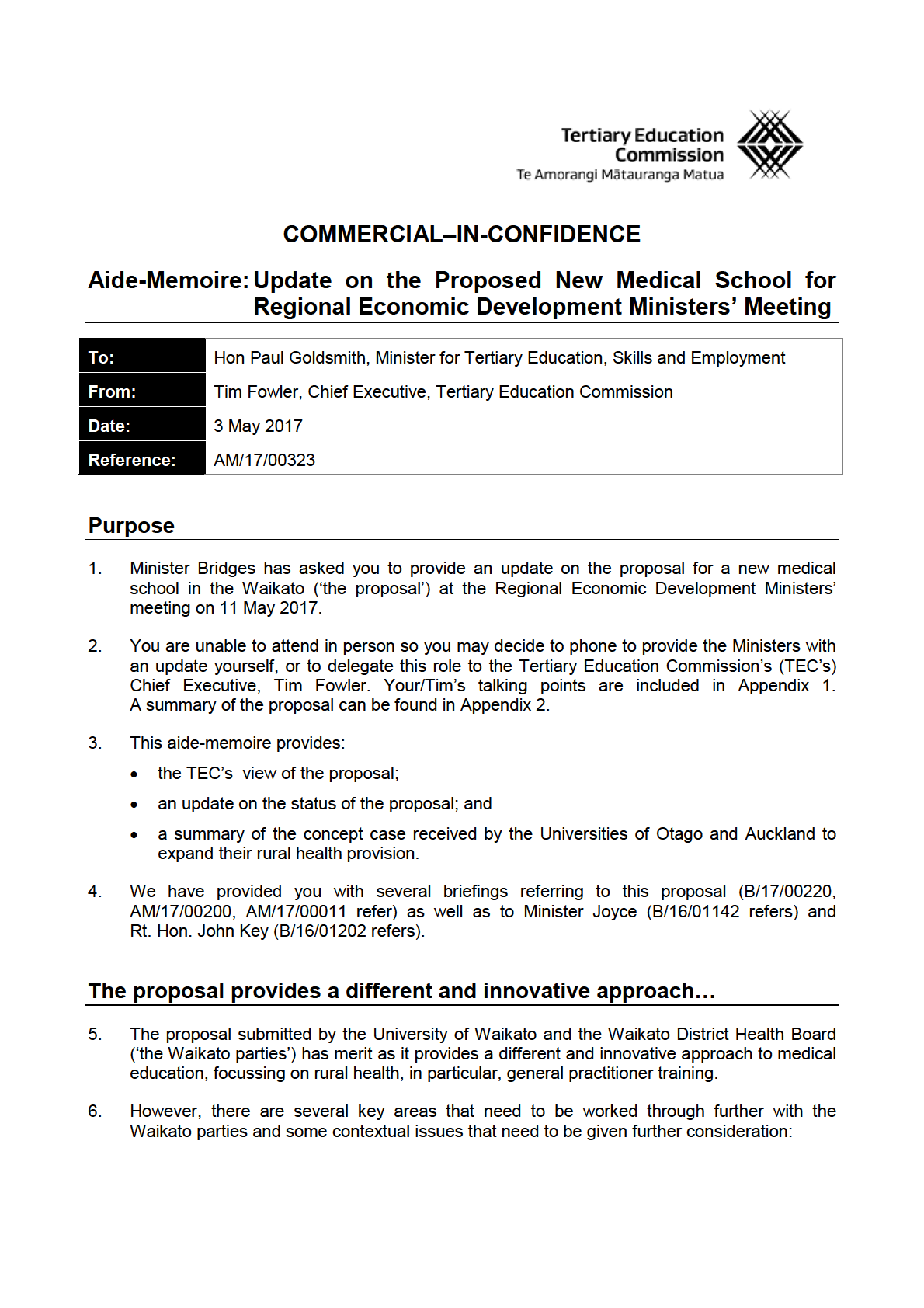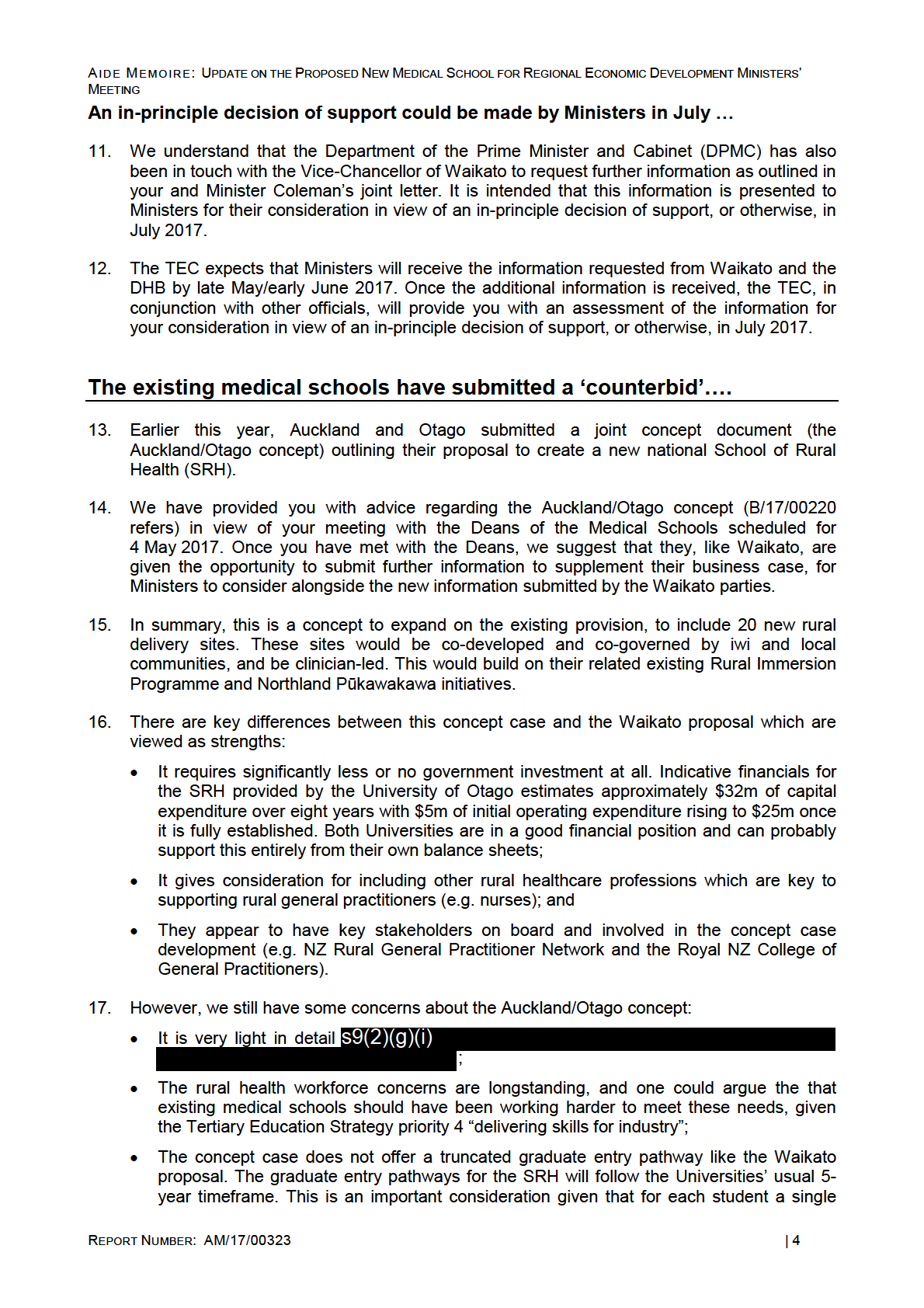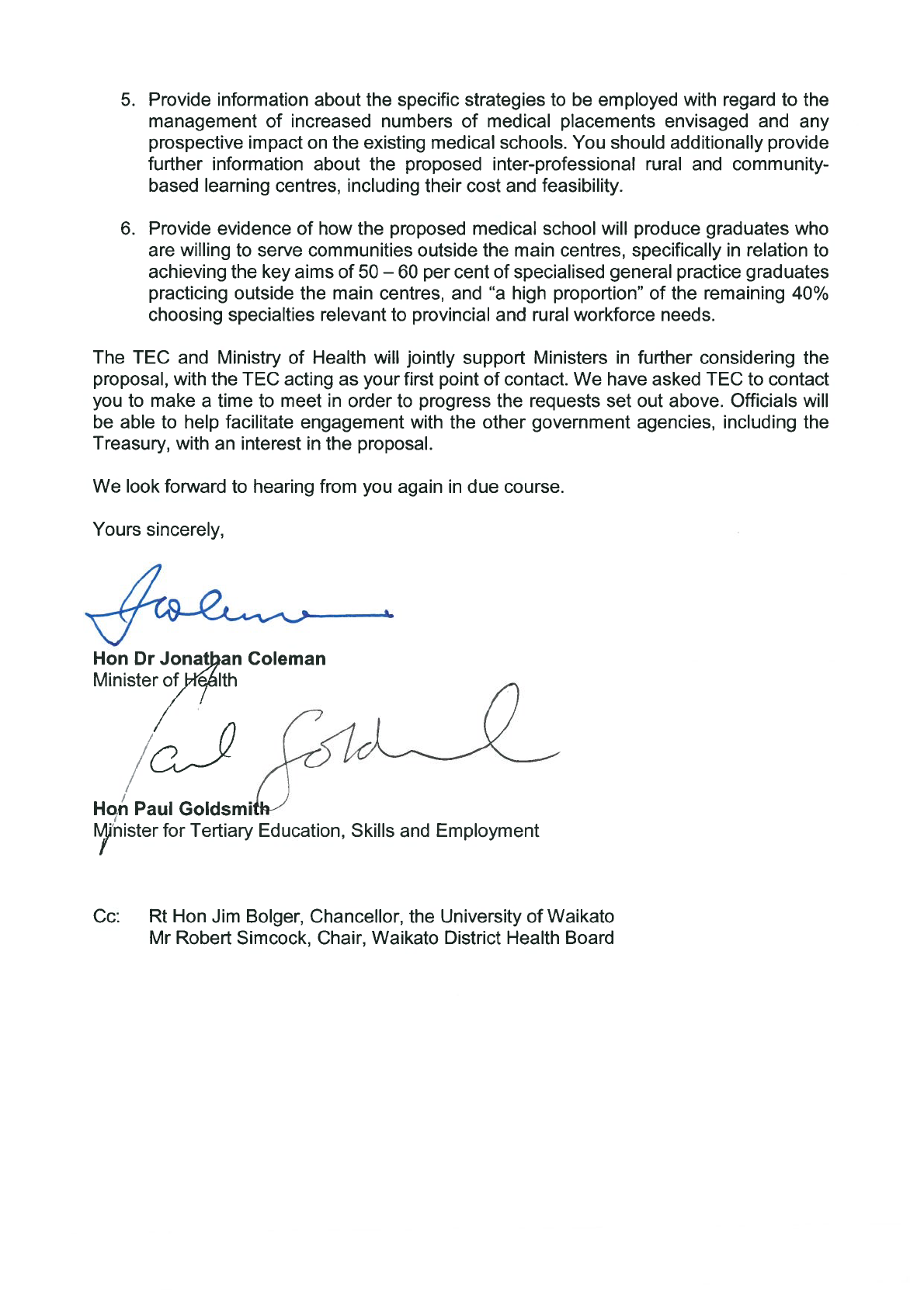
A ID E M E M O I R E : UPDATE ON THE PROPOSED NEW MEDICAL SCHOOL FOR REGIONAL ECONOMIC DEVELOPMENT MINISTERS’
MEETING
•
There are different views as to the problem that the proposal is addressing – there
are differing views regarding the supply and demand for rural general practitioners (GPs).
One view is that there are plenty of medical graduates to meet demand but there is a
maldistribution i.e. less wanting to work in rural and provincial areas over the long-term,
despite additional support being put in to supporting doctors in rural GP practice.
Gaps are filled by international medical graduates. The Waikato proposal indicates that
around 60% of GPs outside metropolitan areas are either locums, or recruited from
overseas and about 25% of rural GP positions are unfilled. There are some concerns as
to whether our reliance on internationally trained doctors is appropriate or sustainable.
•
Are there other solutions to address this issue? Increasing the number of medical
graduates alone will not solve the workforce issues. Medical graduates are increasingly
choosing to pursue specialty rather than general practice, and there are difficulties in
attracting graduates to rural and provincial areas. A new medical school focussing on
graduates for rural health is only one of the options in the suite of possible measures to
address these workforce issues. The suite of measures includes, for example:
i.
providing greater support to rural staff (e.g. locum relief for vacations and
continuing medical education – which is being done by the Ministry of Health in
conjunction with the rural GPs organisation);
ii.
ensuring that doctors in training have rural placements and experience (e.g. the
Otago/Auckland proposal); and
iii.
voluntary bonding schemes (currently being reviewed by Health Workforce NZ).
•
There is a significant capital and operational cost – Over a 10-year period, capital
expenditure is estimated to be between $58m and $70m, and operating expenditure
between $142m and $174m. Waikato has indicated that it may be able to finance up to
$20m itself through its fund-raising (including the $5m offer of support by philanthropist
Sir Owen Glenn which was in the media earlier this year). Waikato has a relatively small
balance sheet and so it would be seeking at least $40m of capital from the Crown to
finance new facilities. Usually, Tertiary Education Institutions (TEIs) are expected to fund
capital projects from their own balance sheets, but there have been previous exceptions
i.e. capital funding was provided to Canterbury TEIs to help them recover from the
2010/11 earthquakes. According to the proposal overall operating expenses will amount
to at least $142m in the first 10 years. Once the school is fully operational and the
maximum number of students recruited (60 in each cohort) the annual Student
Achievement Component (SAC) funding required will be $10m ($2.52m per student
cohort at the current rate of $42k per EFT per annum). This amount is just SAC funding
for the medical students and does not include funding for PhD students and clinical
placements, for example, therefore, government will have to carefully consider its overall
spending priorities. The Waikato parties will clarify all funding sources (e.g. student tuition
fees) in the next few weeks.
•
Clinical placements could be put under pressure – the Universities of Auckland and
Otago have reported that an increase in the number of students will put pressure on the
already short supply of student clinical placements and for the trainee intern (final year of
qualification). It is unclear the extent to which this will be a real issue as there are
potentially unused rural clinical placements within district health boards (DHBs) around
the country. The Waikato parties have also indicated they will broaden the scope of
placements for their students to ease this pressure. However, there will still likely be
pressure on essential training placements such as in the emergency department.
•
Stakeholder support is variable – there are mixed messages of support from key
stakeholders such as DHBs. It is possible that stakeholders wanting to preserve their
relationships with the existing medical schools may not offer support to the Waikato
proposal until they are sure it will go ahead, as they may be concerned about getting
offside with existing partners. However, Waikato reports having done significant work on
stakeholder engagement since the original proposal was submitted in October 2016.
REPORT NUMBER: AM/17/00323
| 2
A ID E M E M O I R E : UPDATE ON THE PROPOSED NEW MEDICAL SCHOOL FOR REGIONAL ECONOMIC DEVELOPMENT MINISTERS’
MEETING
•
Will the proposal be effective in getting more people into rural practice? There are
published reviews of evidence that students who have rural clinical placements as part of
their training are more likely to pursue rural practice (Farmer et. al., 20151) and that those
who come from a rural background are more likely to remain in rural practice (Verma et
al., 20162). Whilst the proposal aligns with the evidence in terms of student selection,
there are no guarantees it will entirely solve the workforce issues.
•
Benefits for the Waikato economy – while this has not been calculated as yet, there are
likely to be benefits for the local economy both associated with the initial set up and
construction, as well as the expansion of the University.
More detailed information to supplement the proposal is on its way…
7.
You have sought further information from the Waikato parties through the joint letter from
yourself and Minister Coleman dated 11 April 2017 (Appendix 3). In summary, more
information that addresses six key issues has been requested:
• details on the quantum and source of funding sought;
• the long-term affordability of the programme;
• a stronger management case that clearly outlines a high-level project plan;
• engagement with key stakeholders including government and regulatory organisations;
• student clinical placements and the impact on existing medical schools; and
• retention in the workforce.
8.
The TEC has since met with representatives from Waikato and the DHB to discuss the
information requested and agree on the next steps, timeline and their future engagement with
government agencies.
The Waikato parties will present their proposal and new information to officials in
mid-May…
9.
Waikato and the DHB have agreed to present their proposal, plus the additional information
requested to government officials in mid-May. This will also afford the opportunity for officials
to ask further questions of clarification. This meeting will include representatives from the
TEC, DPMC, Treasury, Ministry of Education, Ministry for Business, Innovation and
Employment (MBIE), and Ministry of Health (including Health Workforce NZ).
10. The TEC will provide you with a progress briefing following the workshop.
1 A scoping review of the association between rural medical education and rural practice location. Jane Farmer, Amanda Kenny, Carol McKinstry and
Richard D Huysmans. Human Resources for Health (2015) 13:27. DOI 10.1186/s12960-015-0017-3.
2 A systematic review of strategies to recruit and retain primary care doctors. Puja Verma, John A. Ford, Arabella Stuart, Amanda Howe, Sam
Everington and Nicholas Steel Verma et al. BMC Health Services Research (2016) 16:126. DOI 10.1186/s12913-016-1370-1.
REPORT NUMBER: AM/17/00323
| 3


A ID E M E M O I R E : UPDATE ON THE PROPOSED NEW MEDICAL SCHOOL FOR REGIONAL ECONOMIC DEVELOPMENT MINISTERS’
MEETING
year of training costs the government $42k in SAC funding, approximately $8k in student
allowance (depending on the student’s eligibility status) and approximately $10k in loans
(based on the average Bachelor student borrowing in 2015). A single year of medical
undergraduate study will cost the student $15k in tuition fees (based on 2017 rates at
Auckland and Otago). This brings the total real cost of an additional year of study to
approximately $75k which does not take into account the opportunity cost of not working
full-time, incurred by the student; and,
• The concept case does not appear to take into account some of the key factors to the
success of recruiting and retaining rural practitioners, such as selecting students who are
of rural origin who are therefore more likely to return to and remain practising in their rural
communities.
18. Otago and Auckland both have healthy balance sheets, and would not need Crown capital to
implement this proposal. However, they may need some operational funding from the Ministry
of Health (Heath Workforce NZ) and/or the TEC (depending on the nature of the training/
placements provided – which is not very clear at this point).
19. This proposal could go ahead alongside the Waikato proposal – both would contribute to
strengthening the supply of health professionals in rural areas.
20. The Universities of Auckland and Otago oppose the Waikato proposal. One of their major
concerns seems to be the pressure that additional students will place on the supply of clinical
placements. You will likely hear more about the Universities’ concerns when you meet with
the Deans of the Auckland and Otago Medical Schools in early May (B/17/00220 refers). The
Ministry of Health (MOH) have also written a briefing to the Minister of Health with TEC
official’s input. The MOH briefing recommends to Minister Coleman that he shares the
briefing with you. Furthermore, the briefing recommends that both you and Minister Coleman
jointly invite the Universities of Auckland and Otago to provide further information on their
concept case, following a similar approach that was taken with the Waikato proposal.
21. We suggest that, following this meeting, you and Minister Coleman formally seek further
information from Otago and Auckland in a similar manner to the approach followed for the
Waikato proposal. Of course, it is less well developed, and therefore a response would take
longer.
Tim Fowler
Hon Paul Goldsmith
Chief Executive
Minister for Tertiary Education, Skills and
Employment
Tertiary Education Commission
__ __ / __ __ / __ __
3 May 2017
REPORT NUMBER: AM/17/00323
| 5
A ID E M E M O I R E : UPDATE ON THE PROPOSED NEW MEDICAL SCHOOL FOR REGIONAL ECONOMIC DEVELOPMENT MINISTERS’
MEETING
Appendix 1 – Your or Tim Fowler’s talking points
What is the proposal offering and what will it cost?
• The Waikato proposal is a four-year, graduate-entry medical school programme with
students able to enter from any prior degree programme providing they meet academic and
dispositional criteria.
• The rationale for a new medical school is to address the shortage of rural practitioners (rural
GPs and associated specialities) in the medical workforce by recruiting students more likely
to want to work in rural areas, and ensuring they have significant experience in rural
placements in their training.
• The focus will be on accepting students who come from rural NZ and who are keen to pursue
rural practice. It is envisaged that many of these students wil be Māori, reflecting the
demographics of the Waikato region.
• The new school would be based in Hamilton, with clinical education and training centres
located throughout the central North Island. This will enable students to undertake a high
proportion of clinical placements in community settings outside the main centres.
• The Waikato proposal envisages enrolling up to 60 students a year from 2020.
• Waikato and the DHB are hoping to secure capital funding from the Crown to finance the
school with operating revenue coming from TEC funding. Over a 10-year period, capital
expenditure is estimated at a minimum of $58m and operating expenditure a minimum of
$142m.
Ministers Coleman and Goldsmith have requested further information which is due in May…
• The Waikato business case has merit as it provides a different and innovative approach to
medical education, focussing on general practitioner training and rural health.
• The TEC has met with Waikato and the DHB to request further information that addresses
six key issues should be provided:
i. Greater details on the quantum of funding sought and the nature of that funding
including all potential funding sources of financing (such as leveraging the balance
sheets of the University and Waikato DHB, borrowings and public-private
partnerships etc.);
ii. the long term affordability for both the University and the DHB of the proposal
(including a 10-year financial model upon which affordability and sustainability of the
model will be assessed);
iii. a stronger management case that clearly outlines a high-level project plan describing
the critical pathway from reception to implementation, and the risks associated with
the project;
iv. engagement with key stakeholders such as the Royal College of General
Practitioners as well as government (e.g., Health Workforce New Zealand) and
regulatory organisations (e.g. the Medical Council);
v. details on the strategy to manage the increase in student numbers on clinical
placements and the subsequent impact on existing medical schools; and
vi. retention in the workforce – provide more detail on their strategy to ensure those who
enter the rural workforce remain there.
REPORT NUMBER: AM/17/00323
| 6
A ID E M E M O I R E : UPDATE ON THE PROPOSED NEW MEDICAL SCHOOL FOR REGIONAL ECONOMIC DEVELOPMENT MINISTERS’
MEETING
• We expect to have this information at the end of May and will analyse it in conjunction with
other officials.
An in-principle decision of support, or otherwise, could be made by Ministers in July …
• It is intended that this information is presented to Ministers for their consideration in view of
an in-principle decision of support, or otherwise in July.
• TEC is coordinating the analysis and provision of advice along with officials from MoH,
Health Workforce NZ, MBIE and Treasury. DPMC is also involved.
• We also anticipate requesting further information from the Universities of Auckland and
Otago to supplement the concept case they submitted to government as a counterbid to the
Waikato proposal. Whilst this concept case is not as developed as the Waikato business
case (and won’t be able to be in a short timeframe) by the time Minister make any decisions,
it will at least allow for some comparisons between the proposals.
REPORT NUMBER: AM/17/00323
| 7
A ID E M E M O I R E : UPDATE ON THE PROPOSED NEW MEDICAL SCHOOL FOR REGIONAL ECONOMIC DEVELOPMENT MINISTERS’
MEETING
Appendix 2 – Summary of the Waikato proposal
The Waikato proposal is a four-year, graduate-entry medical school programme
• In 2016, the University of Waikato (Waikato) and the Waikato District Health Board (DHB)
submitted a joint business case to Hon. Steven Joyce, then Minister for Tertiary Education
Skills and Employment, proposing to establish a new medical school (‘the School’).
• The proposed programme is a four-year graduate entry programme with students able to
enter from any prior degree programme providing they meet academic and dispositional
criteria.
• The focus of the School will be on accepting students keen to pursue rural practice, and
likely to continue to practice within the region (or within other rural areas in New Zealand).
Many of these students wil likely be Māori, reflecting the demographics of the Waikato
region.
• The new school would be based in Hamilton, with clinical education and training centres
located throughout the central North Island, largely in community care settings. This will
enable students to undertake a high proportion of clinical placements in community settings
in rural and provincial areas.
• The Waikato proposal specifies enrolling up to 60 students a year from 2020. Waikato and
the DHB are hoping to secure capital funding from the Crown to finance the school’s
establishment. Operating funding would come from SAC, student fees, and from funding for
clinical placements as with the normal funding for medical education. Over a 10-year period,
capital expenditure is estimated to be between $58m and $70m, and operating expenditure
between $142m and $174m.The SAC component each year will be $2.52m per annum for up
to 60 students at the current rate of $42k per EFT. Therefore once the school is fully
operational and the maximum number of students recruited (60 in each cohort) the annual
Student Achievement Component (SAC) funding required will be $10m.
The rationale for the School is to address the shortage of rural practitioners in the
medical workforce
• Waikato and the DHB indicate there is currently a shortage of rural GPs and associated
specialities. Therefore, student recruitment at the Waikato school would focus on selecting
students who from the outset are more likely to choose rural practice.
• The Waikato proposal indicates that New Zealand imports around 1,100 doctors per year to
meet its medical workforce needs. These doctors comprise around 60% of the psychiatry,
palliative medicine, obstetrics, rehabilitation, and elderly care workforce.
• The proposal also notes that only 15% of current medical school graduates elect to enter
general practice with the result that around 60% of GPs outside metropolitan areas are either
locums, or recruited from overseas. Despite this, around 25% of rural GP positions are
unfilled and with 40% of existing GPs set to retire by 2025, there are risks that rural areas will
be further under-served.
REPORT NUMBER: AM/17/00323
| 8
A ID E M E M O I R E : UPDATE ON THE PROPOSED NEW MEDICAL SCHOOL FOR REGIONAL ECONOMIC DEVELOPMENT MINISTERS’
MEETING
Appendix 3 – Letter sent to University of Waikato and Waikato DHB
REPORT NUMBER: AM/17/00323
| 9






